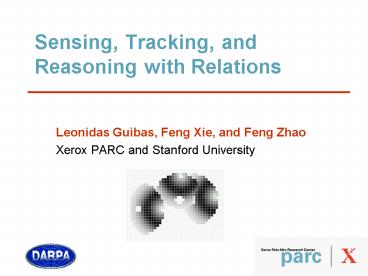Sensing, Tracking, and Reasoning with Relations - PowerPoint PPT Presentation
Title:
Sensing, Tracking, and Reasoning with Relations
Description:
Select initial sensors whose readings would generate desired initial belief state shapes. ... Target location belief states are represented as 2-d arrays. ... – PowerPoint PPT presentation
Number of Views:48
Avg rating:3.0/5.0
Title: Sensing, Tracking, and Reasoning with Relations
1
Sensing, Tracking, andReasoning with Relations
- Leonidas Guibas, Feng Xie, and Feng Zhao
- Xerox PARC and Stanford University
2
Sensing for Reasoning and Acting
A system of collaborating sensors should provide
data that can
- Lead to high-level understanding of a situation
- Support efficient decision-making
- Allow for efficient updates as the world-state
changes
Clustering of enemy forces
Optimal route selection
3
Focus on Relations between Objects
High-level reasoning is often based on relations
between objects, or other aggregate information.
Focusing on relations has many advantages
- Data size relational or aggregated information
can be compactly encoded and efficiently
transmitted - Robustness aggregated information can be
statistically more robust than individual data - Sensor control Reasoning is naturally
relation-based well-established theories exist
on how to go from observations to conclusions
a
c
4
Example Am_I_Surrounded?
We have a relatively flat terrain with friendly
(white) and enemy (black) vehicles, stationary or
moving.
The field contains PIR and acoustic amplitude
sensors. We want to know when a friendly vehicle
is surrounded by enemy vehicles. Say
surrounded ? inside the convex hull
5
Am_I_Surrounded via CCW Relations
The notion of being surrounded can always be
captured by a a number of CCW predicates on the
vehicle positions.
CCW(a,b,c) asserts that the triangle defined by
a, b, and c is counterclockwise oriented. CCW
predicates can capture the notion of the convex
hull of a set of points, and the notion of
inclusion in a convex polygon or triangle.
6
Direct Sensing of CCW Relations
- s1, s2, and s3 are PIR sensors
- They directly sense the relations CCW(f,e1,e2),
CCW(f,e2,e3), and CCW(f,e3,e1). - From these relations, the containment of f in the
triangle defined by e1, e2, and e3 follows.
7
Target Localization for CCW Relations
In general, direct sensing is not possible.
However, by sufficiently localizing the targets,
CCW relations (or their negations) can be
estimated with high confidence.
CCW relations can be estimated using the current
belief state of the system about the location of
each target. Improved estimation requires a
non-trivial sensor selection strategy.
For CCW(t1,t2,t3), s2 is more valuable than s1.
8
An Example CCW Using Distance Sensors
We are given three targets t1, t2, and t3. Two
acoustic amplitude measurements per target were
used to obtain the distributions shown. Our goal
is to have (say) 90 confidence that
CCW(t1,t2,t3) is true. This is not yet the case
in the current belief state additional sensing
is necessary to improve localization. We assume
the sensor field is known.
t1
t2
t3
Darker color indicates higher likelihood. The x
indicates actual target location, the x expected
location. The indicates location of the last
sensor used.
9
Overview
If uncertain, else
Report Relation
10
Initialization
- Set up sensor model
- Generate sensor map
- Generate target locations with three different
geometric relation, acute, round and skinny - Select initial sensors whose readings would
generate desired initial belief state shapes.
11
Data Structure Setup
- Estimate initial belief states
- Construct multi-res belief states
- Initialize the triplet bins, ccw bin and non cw
bins are both empty, uncertain bin have one
triplet of mass 1 formed by the 3 pyramid tops
12
Computing the CCW confidence
Target location belief states are represented as
2-d arrays. A quad-tree-like multi-resolution
structure is superimposed, to speed up
computation.
Triplets of quad-tree tiles, one from each
target, are classified as CCW, not CCW, or
undetermined.
Undetermined tile triplets are refined until the
mass in the CCW or not CCW bins exceeds the
desired threshold, or until a triplet budget is
exceeded.
13
Sensor Selection Strategies
- Use Mahalanobis distance and cycle among the
targets. - Use a geometric heuristic this selects a sensor
close to the perpendicular from one target to the
line through the other two. - Use expected reduction in uncertainty, based on
the current belief states and the known sensor
locations. - To have ground truth, simulate the effect of
using each sensor, and choose the one that
actually reduces uncertainty the most.
14
Geometric Heuristic
15
Round Robin using IDSQ
16
Expected Ideal
- Compute expected belief state using current
belief state of a target and the new sensor
location. - Select the sensor-target pair whose expected
belief state gives the best improvement in
resolving relation uncertainty - Because not all triplet are resolved, the
reduction in relation uncertainty is only an
estimate. - This method is very expensive and not always
effective.
17
Using the Target Cycling Heuristic
2
3
4
5
Uncertain mass
CCW mass
18
Using the Geometry Heuristic
2
3
Reduction in uncertainty is less.
4
5
19
Result Analysis
- Geometric Heuristics
- effective for a variety of target configurations
- effective for a variety of sensor maps
- very cheap to compute
- Round Robin
- effective for a variety of target configurations
- sensitive to sensor map distribution (best for
uniform sensor map) - can be computed in real time
20
Tracking the Am_I_Surrounded Relation
As vehicles move, we maintain three CCW relations
establishing that the friendly vehicle is indeed
in a triangle formed by three enemy vehicles.
When the friendly vehicle escapes the triangle,
the sensor net searches for a new enemy vehicle
that can still establish containment.
The triplet basis is maintained under motion.
21
Conclusion
- Sensing and tracking with relations provides a
new approach to sensor exploitation. - The approach allows the sensor net to focus its
resources towards the task at hand and take
advantage of discrete reasoning. - It also raises many new and interesting problems
on task decomposition, sensor selection, recovery
from failure, etc.































